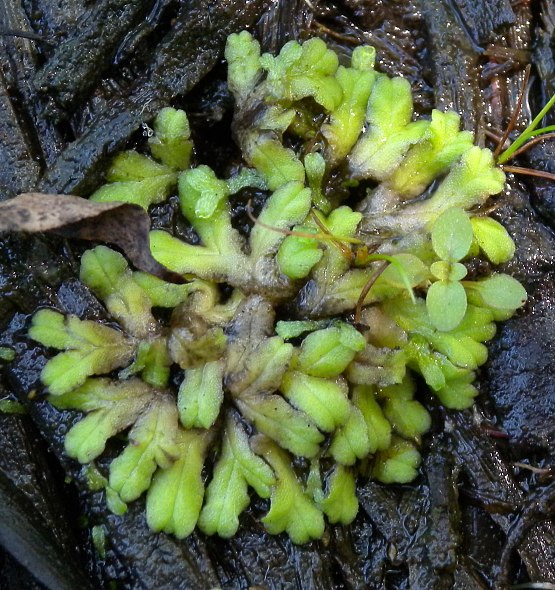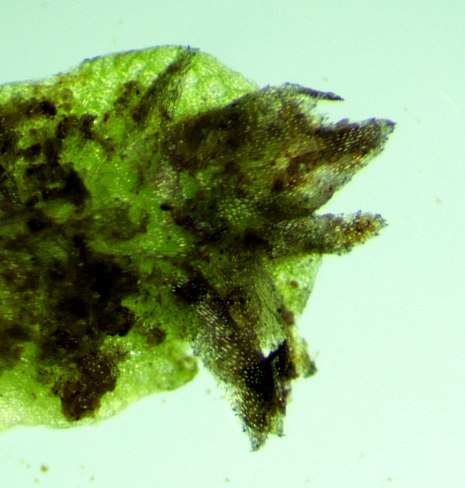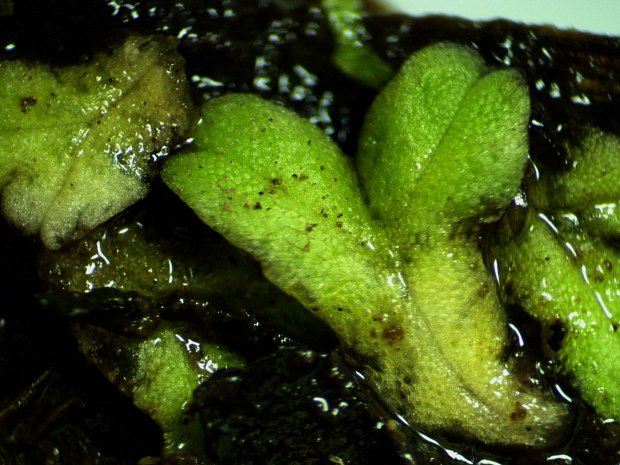
The thallus of a stranded-terrestrial plant is similar to the floating-aquatic form of the thallus, except the former is more branched and it tends to form a rosette-like shape up to 20 mm. across. The lower side of the thallus for stranded-terrestrial plants has far fewer purplish scales and they are much shorter in length. In contrast to the floating-aquatic form, the lower side of the thallus of stranded-terrestrial plants develops short peg-like rhizoids and long smooth rhizoids. The peg-like rhizoids absorb moisture from the ground, while the smooth rhizoids anchor the entire plant to the ground. For both forms of this plant, there is a faint reticulated network on the upper surface of the thallus (visible with 10x hand lens). In the middle of each polygonal section of this network, there is a single chambered air pore and several layers of minute air bubbles (visible with higher magnification). The floating-aquatic form of this plant reproduces asexually during the growing season by breaking apart into 2 or more smaller plants as the older lobes decay. The stranded-terrestrial form of this plant is able to reproduce asexually after it overwinters and all but its growing tips decay. These growing tips float to the surface of the water during spring rains of the following year, forming several new plants.

Sexual reproduction can occur when this plant occurs in bodies of temporary water (seasonal ponds, vernal pools, and other temporary wetlands). Because this plant is monoecious, both antheridia (male reproductive organs) and archegonia (female reproductive organs) develop within the same thallus. Spores are formed when the eggs of the archegonia are fertilized by the sperm of the antheridia. Individual spores are about 50 micrometers across, black, and spiny. The spores are released from the thallus as its older lobes decay; they are distributed in part by water. However, the spores do not germinate until at least a year after their release; this usually occurs during the spring.
Cultivation: The preference is full sun to light shade, shallow water or wet conditions, and soil containing sandy silt, sand with decaying organic matter, or mud. This plant is a floating aquatic on surface water, it also adapts to wet shorelines. It remains green throughout the growing season, but turns black and has a tendency to disappear during winter. Both slowly moving water and stagnant water are tolerated.

Range & Habitat: Fringed Heartwort (Ricciocarpos natans) occurs occasionally throughout Illinois, where it is native (see Distribution Map). It is widely distributed in the United States and Canada, and it also occurs in Europe. In Illinois, habitats include typical ponds and sandy ponds, limestone sinkholes, shorelines of small lakes, shorelines and banks of rivers, open water and shorelines of strip mine impoundments, mudflats in rivers, vernal pools in wooded areas, puddles and muddy areas of floodplain woodlands near rivers, oak flatwoods that flood intermittently, open water and wet ground in swamps (including Bald Cypress swamps), fallen logs in swamps, and wet willow thickets. Fringed Heartwort is found in average to high quality wetland areas where there are either permanent or temporary bodies of water, especially in sandy areas. It is less common in degraded wetland sites.
Faunal Associations: Information about floral-faunal relationships for Fringed Heartwort (Ricciocarpos natans) is limited. In Sweden, Mallard ducks used this plant as a source of food (Hartman, 1985). Mallards and other ducks probably feed on it in North America. Some turtles may feed on this plant as well. Waterfowl, including ducks and geese, may help to spread the spores of this plant to new wetland areas as the spores may cling to their muddy feet and other body parts. The long membranous scales of this plant in its floating form provide cover and protection for various small aquatic invertebrates.

Photographic Location: Shoreline of an open body of water in a sandy swamp at the Heron County Park in Vermilion County, Illinois.
Comments: Fringed Heartwort (Ricciocarpos natans) is a thalloid liverwort. Like the mosses, it is a non-vascular plant. The appearance of this plant is similar to several Crystalwort species (Riccia spp.), except it forms purplish scales and sometimes rhizoids along its underside. Another difference is the presence of several layers of minute air bubbles in the thallus. Most Crystalworts are terrestrial species that are found in drier areas, although Floating Crystalwort (Riccia fluitans) is an exception. This latter species lacks furrows on the upper side of its thallus and its lobes are more narrow than those of Fringed Heartwort. Thus, it is not difficult to distinguish between them. Other common names of Ricciocarpos natans are Purple-fringed Riccia and Floating Liverwort. A common misspelling of the scientific name is Ricciocarpus natans. An obsolete scientific name for this species is Riccia natans.